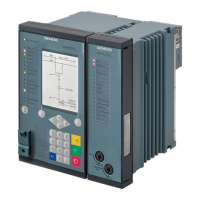[losvsbfp-090712-01.tif, 2, en_US]
Figure 7-2
Function Logic Overview
Function Description
The Circuit-breaker failure protection function is started by device-internal protection functions and/or exter-
nally (via a binary input or an interface, such as GOOSE).
Internal Start
By default, each device-internal protection stage, that has to control the local circuit breaker, starts the circuit-
breaker failure protection. The function is started by the tripping of the protection stage. In the default setting,
the starting signal Internal. Hold starting signal (see Figure 7-3, Figure 7-4) is held when the
pickup signal has a falling edge or the protection function has tripped. The Circuit-breaker failure protection
function can in this case only drop out if the circuit breaker is detected to be open. This is detected using the
current flow or circuit-breaker auxiliary contact criterion. If necessary, the Circuit-breaker failure protection
function can also drop out when the pickup signal has a falling edge or the protection function trips (internal
starting signal is not held).
Using routing, you can specify whether individual protection stages or protection functions are to be used as
the starting source or whether starting happens only externally.
The internal starting sources are routed in the protection function groups via the Circuit-breaker interaction
entry (for this, see 2.1 Function Embedding in the Device).
7.1.3
Protection and Automation Functions
7.1 Circuit-Breaker Failure Protection
SIPROTEC 5, High-Voltage Bay Controller, Manual 517
C53000-G5040-C015-9, Edition 11.2017

